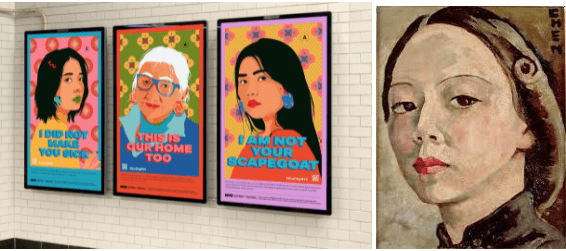Wenhao Cai

Amanda Phingbodhipakkiya, Georgette Chen Yi Ling, I Still Believe in Our City (2020) Self Portrait (1946)
I hate the hyphen. The word and label “Asian-American” began to imbed itself in my soul, my spirit, and my body from a very young age. As the daughter of two Chinese immigrants who solely speak Mandarin at home, and the student of predominantly white private schools, my own relationship with American/Western ideals as a woman of color has become increasingly complicated as I grow up. Don’t let its appearance fool you, the term “Asian-American” does not define my identity and my insecurity at all. It means that while being half of something and half of another, I could never truly find belonging in either. I like to call this my “life’s greatest ultimatum” because to commit to one means to sacrifice the culture, language, and appearance of the individual, one that I don’t want to make. To add another layer in my complications, a few months back I read a quote in the New York Times of the activist and author, Helen Zia saying “We’re seen as vulnerable… You know — the object that won’t fight back”. I realized that my experiences as a girl and as an Asian-American are deeply intertwined in my own feelings of voicelessness. The words shackle me to my mind, telling me that my voice does not matter; So I let it.
The Atlanta spa shooting in March of 2021 shed light on the violence that I was numb to and my own ignorance about the subject should have deeply disturbed me. Most of all, I was angry that I had not been taught to care about my own heritage. While my environment did not foster a space for my voice to be heard, I realized that it was time to stop waiting around. I turned to powerful, female, Asian artists like Amanda Phingbodhipakkiya and Georgette Chen Li Ying for the representation and voice I did not have.
Due to the rise of Asian hate crimes, throughout November and December of 2020, New York City saw a variety of colorful portraits that raised awareness for the issue by artist Amanda Phingbodhipakkiya. Phingbodhipakkiya was born to immigrant parents from Indonesia and Thailand. Seen on the side of bus stations, in the subway, and other forms of transportation, the posters brought a voice to the Asian community that has often been overlooked by their own government. Some say anti-discriminatory phrases like “I am not your scapegoat” and “I did not make you sick”, advocating for Asian voices and lives. The point is clear, Asian Americans and other people of color are tired of the way they are treated and their invisibility in their community. While all the violence towards people of color ensues in our nation, the artist chooses to celebrate diversity instead. These portraits show courage in the way these men and women of all color pose, and an unwillingness to stay silent and afraid through the beautiful, bold colors. Although the art is simple, easy to understand, and largely pleasing in its aesthetic, it does not feel the need to go above and beyond to be revolutionary and game-changing. Its ability to reach a mass audience, to raise awareness, and to give hope and a voice to a heartbroken and hurting society, is why I cannot deny its power as art. Her art came at a time where I felt overlooked, but through her art, I felt validated and for once in my life, heard.
Looking at the work of another female Asian artist named Georgette Chen Li Ying who was born over 100 years ago in China, her art became influential to me in the way it celebrates life. Born in 1906 in Zhejiang Province, China, and the fourth of twelve children, Chen studied in New York City, Paris, and later on in Singapore. Her Post-Impressionistic style oil paintings take inspiration from Western art and apply it to her own culture. Her own self-portraits are incredibly expressive and show the character of a strong, determined woman. Her commitment to education led her to become the first woman to teach at the Nanyang Academy of Fine Arts and was a pioneer of fine arts in Singapore.
As a young Chinese-American artist, I love seeing the Asian face shape being regarded as the subject of art and something to be celebrated. Throughout my life, I have felt the weight of wanting to embody white beauty standards and how it feels for my own history to be written out of the historical narrative in my education. At school, I learn history through the Eurocentric and Western lens, where the people who were deemed important were white influential men; In art, I intimately engage in the way a white person’s eye is shaped. Through this process, I begin to forget the importance of my own unique features and history. Artists like Amanda Phingbodhipakkiya and Georgette Chen remind me that diversity in and of itself is beautiful. Through their art, they show that we are not limited by our identity or the hyphen, but instead empowered, and respected, for it.
Bibliography:
“Amanda Phingbodhipakkiya.” Times Square Arts, arts.timessquarenyc.org/times-square-arts/artists/amanda-phingbodhipakkiya/index.aspx. Accessed 30 July 2021.
Creamer, Ruth. “Georgette Chen.” Singapore Infopedia, eresources.nlb.gov.sg/infopedia/articles/SIP_698_2005-01-12.html. Accessed 30 July 2021.
Dewan, Shaila. “How Racism and Sexism Intertwine to Torment Asian-American Women.” The New York Times [New York City], 18 Mar. 2021. The New York Times, www.nytimes.com/2021/03/18/us/racism-sexism-atlanta-spa-shooting.html. Accessed 30 July 2021.
“I Still Believe in Our City.” I Still Believe, www.istillbelieve.nyc/about. Accessed 30 July 2021.
Messman, Lauren. “‘I Still Believe in Our City’: A Public Art Series Takes On Racism.” The New York Times [New York City], 4 Nov. 2020. The New York Times, www.nytimes.com/2020/11/02/arts/design/public-art-covid-race-subway.html. Accessed 30 July 2021.